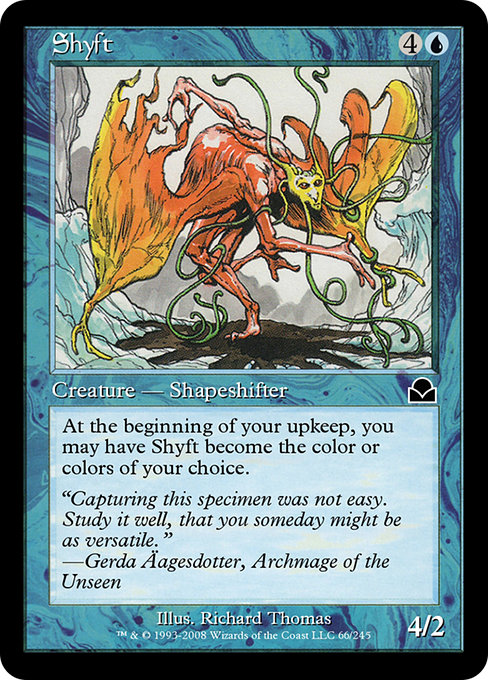
Image courtesy of Scryfall.com
Art Style Shifts in Magic: The Gathering: A Shyft Through Time
If you’re a fan of the multiverse as much as the multiverse loves to throw a curveball, you’ve noticed how MTG art resale values not only capture moments of gameplay but also the era that produced them. Shyft, a blue shapeshifter from Masters Edition II, serves as a perfect lens for exploring how card art evolved from the late 1990s into the bold digital era. With a mana cost of 4U and a sturdy 4/2 body, Shyft wasn’t just a mechanical oddity; it embodied a philosophy: blue’s affinity for adaptability, cleverness, and a touch of mystery. 🧙♂️🔥💎
The 1990s: raw fantasy, bold linework, and iconic frames
Shyft’s 1997 frame places it firmly in the era when Magic’s visual language leaned into high-contrast, painterly fantasy with strong outlines and dramatic shading. The border is black, the frame chunky, and the artwork often carried a sense of improvised magic—like a spell captured between before-and-after moments. In this period, an artist’s linework defined the silhouette; color was expressive but sometimes restrained by printing technology. For players, this meant a card that felt like a relic and a work of storytelling that could be read at a glance. The Shyft image embodies the era’s fascination with shape and possibility—the creature that could become anything, if you looked at it long enough. 🎨
The 2000s: painterly realism meets the Masters bridge
Masters Edition II, released in 2008, acts as a bridge between vintage print conventions and modern digital sensibilities. Shyft’s art by Richard Thomas sits in a space where color and form are more hydrated, with smoother gradients and heightened texture that hint at digital underpinnings while still feeling hand-crafted. The card’s design—a common rarity with a strong, memorable face—invites players to study its shape-shifting promise. The text, “At the beginning of your upkeep, you may have this creature become the color or colors of your choice. (This effect lasts indefinitely.),” reads as a conceptual bridge: blue’s identity as a manipulator of conditions is mirrored in the art as a creature that refuses to stay still. This period also marks a transition in how artwork communicates game concepts, turning a mechanic into a visual vow of versatility. 🧙♂️🎲
“Capturing this specimen was not easy. Study it well, that you someday might be as versatile.” —Gerda Äagesdotter, Archmage of the Unseen
The flavor text reinforces the card’s thematic core: adaptability isn’t just a rule text; it’s a narrative aspiration for both the player and the artwork. The Masters edition aesthetic slows the pace a touch, inviting players to linger on each image, deciphering tiny details in the backdrop—the glint of a spell, the ripple of a magic essence, the moment before the color changes become permanent. This is more than a snapshot of a creature; it’s a manifesto about how you learn to see magic in motion. 🔬
2010s: digital painting becomes the default, while tradition persists
As the 2010s rolled in, MTG art leaned into digital painting as the primary engine for color, texture, and atmosphere. Shyft’s era foreshadowed this trend: a blue shapeshifter that embodies the exact kind of fluidity digital art excels at—soft edge blending, light halos, and nuanced translucency. The art showcased in ME2 sits in a transitional glow: you can still feel the painterly hand, but the surfaces shimmer with a modern polish. For players, this decade offered more legible silhouettes in crowded boards and more defined mood-setting, helping you connect with the creature’s mutable nature even when the board state got chaotic. ⚔️
2020s and beyond: diversity of approach, texture, and narrative depth
Today’s MTG art thrives on collaboration across a broader spectrum of artists and storytelling approaches. The newest frames, the bigger canvas, and the streaming of art direction all contribute to a depth that invites longer gaze and richer interpretation. Shyft’s core idea—indefinite color transformation—still resonates as a metaphor for the game’s evolving identities: players are increasingly encouraged to embrace multiple color identities, cross-pollinate strategies, and celebrate visual diversity. The blue mechanic—color shifting as a perpetual, evolving trait—feels especially timely in a game that invites hybrid decks and innovative combos. 🧙♂️💎
What to look for when appreciating MTG art across decades
- Frame and era: The 1997 frame versus modern borders signals changes in printing tech and artistic emphasis.
- Color treatment: Early art favored crisp contrast; later art embraced nuanced shading and digital glow.
- Storytelling density: Older pieces often foreground action, while newer pieces layer atmosphere, texture, and lore hints.
- Character and concept: Shyft’s theme—color-shifting identity—maps neatly onto how color identity in the game itself has grown more fluid in practice.
- Collector context: Rarity and print runs influence value, but the lasting appeal often comes from how well the art communicates the mechanic’s promise.
Whether you’re a long-time veteran who painted your first mana pool with a Bic pen or a newer player who fell in love with the game through a tablet screen, the evolution of MTG art offers a shared map of the hobby’s heartbeat. The color-shifting shapeshifter is a delightful case study in how art and mechanics reinforce one another—blue’s charisma for manipulation channels into a creature whose very presence hints that nothing on the board is fixed. 🧙♂️🔥
If you’re decorating a desk, a shelf, or your favorite playmat with a touch of retro-modern MTG vibe, consider a stylish nod to your favorite era while keeping your tech in one piece. On that note, a little cross-promo nod: this product pairs nicely with the collector’s mindset—a sleek phone case that wears the same spirit as a well-loved card. Product link below for curious minds and curious collectors alike. ⚔️🎨